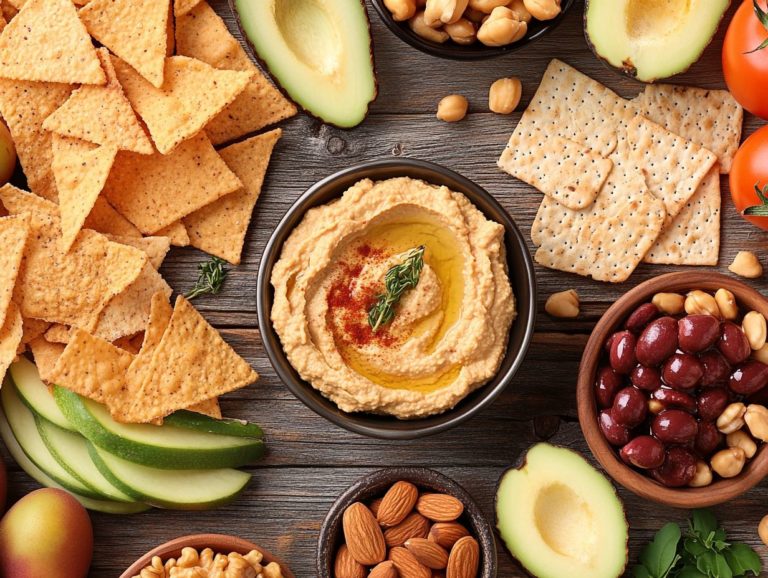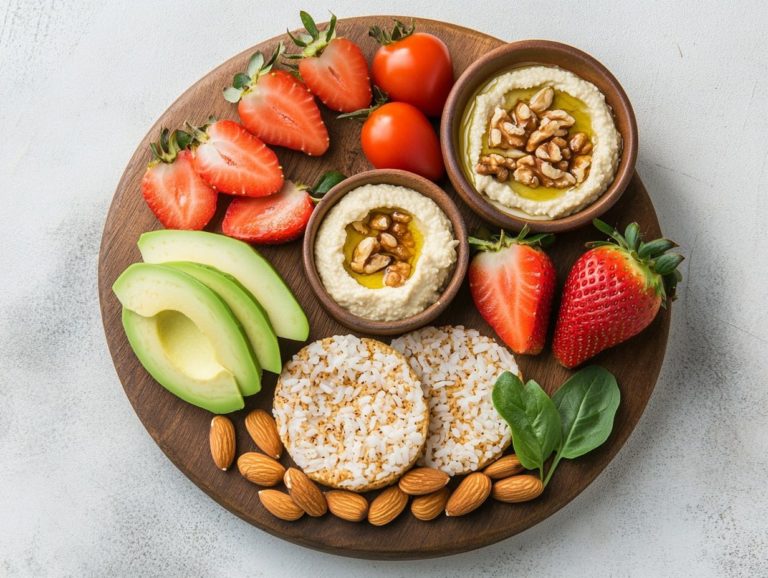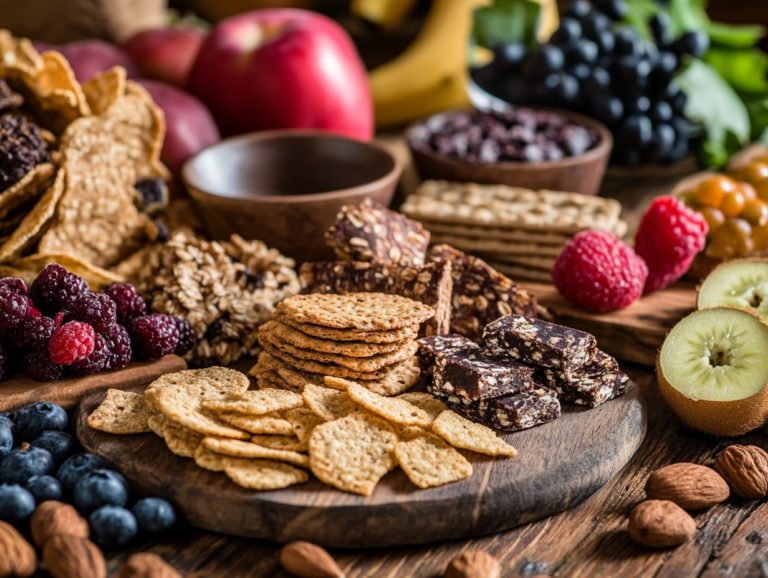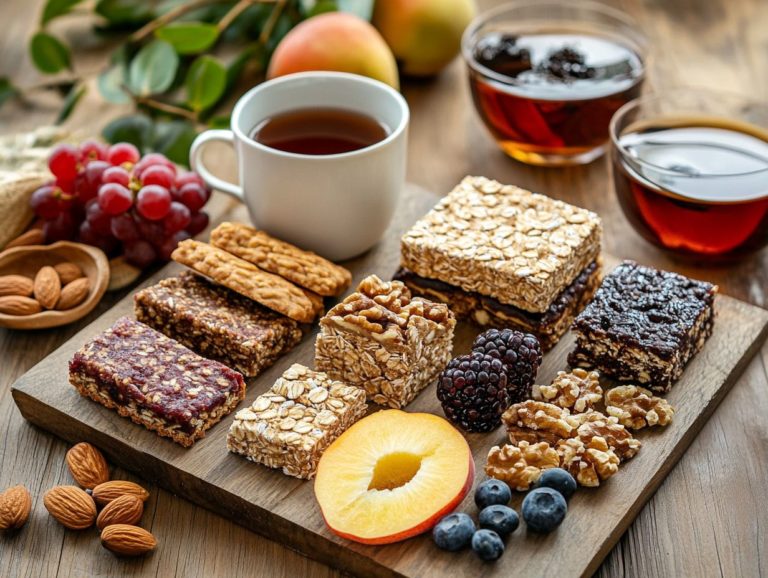Are All Rice Cakes Gluten-Free?
Rice cakes have long been a favored snack, celebrated for their light texture and remarkable versatility. They are a staple in many households and local markets.
As awareness of gluten sensitivity and celiac disease continues to rise, you may find yourself questioning whether these treats are genuinely gluten-free, especially when considering various gluten facts.
This guide delves into what rice cakes are, what gluten actually is, and how rice cakes can seamlessly fit into a gluten-free diet. It also highlights the benefits of gluten-free rice cakes, discusses potential risks, and offers tips to ensure your snacks are safe to enjoy. You’ll also find delicious topping ideas, such as avocado toast, soft goat cheese, and homemade yogurt sauce.
Whether you re in search of a wholesome snack or navigating dietary restrictions, this information will equip you with valuable insights.
Contents
- Key Takeaways:
- What Are Rice Cakes?
- What Is Gluten?
- Are Rice Cakes Gluten-Free?
- What Are the Benefits of Gluten-Free Rice Cakes?
- What Are the Risks of Eating Rice Cakes with Gluten?
- Can Cause Damage to the Intestines in People with Celiac Disease
- Can You Make Your Own Gluten-Free Rice Cakes?
- Frequently Asked Questions
- Are all rice cakes gluten-free?
- Do all brands of rice cakes offer gluten-free options?
- Are flavored rice cakes also gluten-free?
- Can people with celiac disease or gluten intolerance safely consume rice cakes?
- Are all rice cake products labeled as gluten-free?
- Are rice cakes a suitable alternative for those following a gluten-free diet?
Key Takeaways:
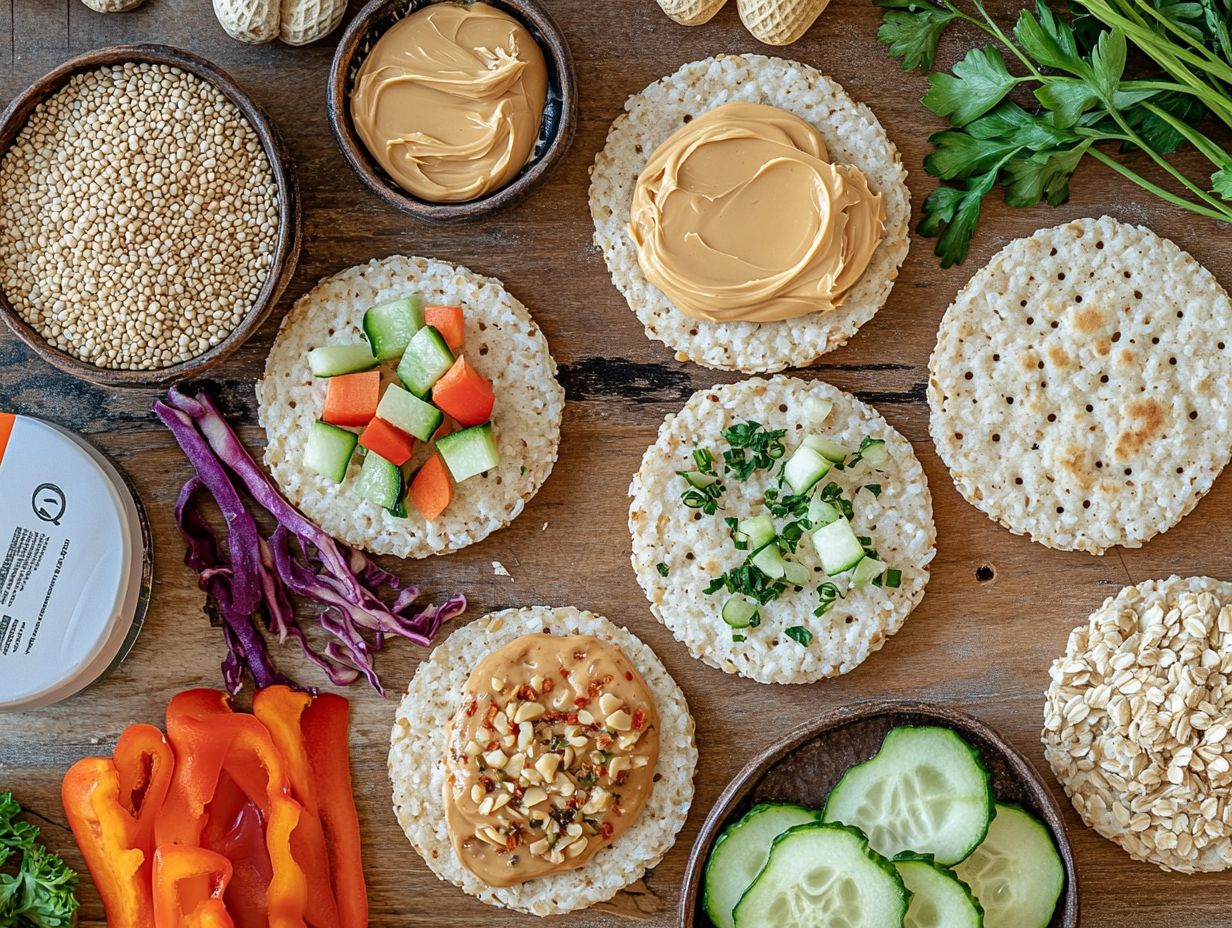
- Rice cakes can be a great gluten-free snack option for those with celiac disease or gluten sensitivity.
- Gluten-free rice cakes can aid in weight loss and improve digestive health.
- It is important to check labels and ingredients to ensure that rice cakes are truly gluten-free and not at risk for cross-contamination during manufacturing.
What Are Rice Cakes?
Rice cakes are a versatile and nutritious snack crafted from puffed rice. They deliver a delightful crunch paired with endless topping possibilities.
You can enjoy them as a gluten-free and dairy-free comfort food, perfectly suited for a variety of dietary preferences, including vegan lifestyles and quick meal ideas.
Widely available in local markets, rice cakes serve as an excellent foundation for healthy snack creations. They invite your creativity with delicious toppings like peanut butter, avocado, olives, cheese substitutes, or even tuna-melt.
What Is Gluten?
Gluten is a group of proteins found in wheat, barley, rye, and other grains. It plays a vital role in giving dough that delightful elasticity and chewiness.
For many, gluten is just another harmless part of a balanced diet. However, for those with celiac disease or gluten sensitivity, eating gluten can cause serious health problems, necessitating a strict gluten-free diet.
If you find yourself affected by these conditions, you may face challenging symptoms that can disrupt your life. Symptoms can include digestive distress, fatigue, and skin rashes.
This makes it essential to completely avoid gluten in your meals, ensuring that any rice alternatives you choose are safe. The rising awareness surrounding gluten and its health implications has created a surge in demand for gluten-free alternatives in grocery stores and restaurants.
In response, many food manufacturers have become more transparent about their ingredient sourcing. They often label products to meet the needs of those with dietary restrictions.
This growing trend shows that consumer preferences are changing, underscoring the importance of making informed choices regarding gluten consumption. Recognizing the broader impact of gluten intolerance on overall health is crucial. Oats are often considered a safe ingredient but should always be scrutinized for gluten-free certification.
Are Rice Cakes Gluten-Free?
Rice cakes are primarily composed of rice, which is naturally gluten-free, making them an appealing option for those following a gluten-free diet.
However, it’s crucial to remember that the gluten-free status of rice cakes can vary based on their ingredients and manufacturing processes. This is why checking the ingredient label is essential.
This emphasizes the necessity of scrutinizing ingredient labels for any potential gluten sources or contamination, particularly for those who are gluten intolerant. Being diligent in this regard ensures a safe and satisfying choice for your dietary needs.
Try out rice cakes today and discover delicious topping combinations that can elevate your snacking experience!
What Are the Potential Sources of Gluten in Rice Cakes?
While rice cakes are primarily made from rice, gluten can be added through additional ingredients or cross-contamination during processing, which is a genuine concern for people with gluten intolerance. Ingredients like flavorings, additives, or even the use of shared equipment with gluten-containing grains can inadvertently introduce gluten into what seems like a safe snack. This means you need to be vigilant when selecting your rice cakes.
Take common additives, for example, like malt extract derived from barley or various flavorings that might not be immediately obvious. They can compromise the safety of a product for individuals sensitive to gluten. The risk of cross-contamination the unintended mixing of gluten with gluten-free foods is another critical factor, especially in facilities that handle multiple grain products. Even if a rice cake looks gluten-free, there’s a significant chance that trace amounts of gluten could find their way into the final product, underscoring the importance of carefully checking ingredient labels. This is particularly crucial for those on a strict gluten-free diet.
For anyone navigating gluten intolerance, understanding and identifying safe options is essential to avoid any adverse reactions. Incorporating a variety of topping ideas like charcuterie rice with cold cuts or salmon rice can enhance the meal experience.
What Are the Benefits of Gluten-Free Rice Cakes?
Nutritional Benefits
If you re avoiding gluten, gluten-free rice cakes could be your new favorite snack! They present a multitude of advantages for those steering clear of gluten, serving as a convenient and nutritious snack that effortlessly aligns with diverse dietary preferences. These benefits are particularly noteworthy for individuals with celiac disease or gluten sensitivity, as well as for those seeking to manage their weight with a low-calorie snack option.
You can also pair them with healthy toppings like black beans, shredded cheese, or a simple mixture of nuts and seeds for an extra nutritional boost.
Additionally, the simple ingredient profile of rice cakes can contribute positively to digestive health, making them a smart choice for anyone looking to enhance their well-being.
1. Suitable for People with Celiac Disease or Gluten Sensitivity
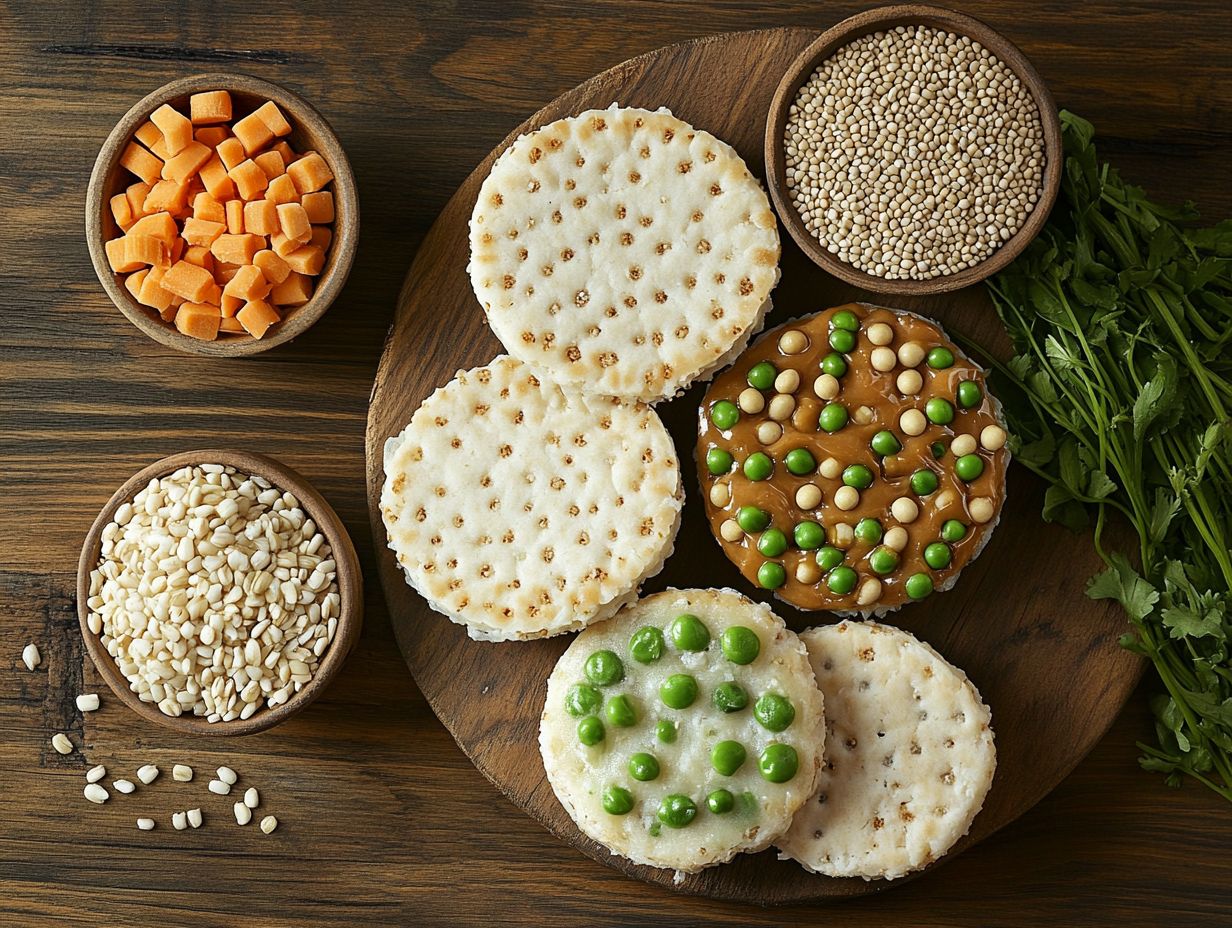
Rice cakes are the perfect snack for those with celiac disease or gluten sensitivity, as their straightforward ingredients typically keep gluten at bay, allowing you to enjoy them without a second thought. These gluten-free delights not only offer a satisfying crunch, but they also provide a versatile canvas for a variety of healthy toppings that can elevate their nutritional profile.
Not only do rice cakes serve as an adaptable base for your meals and snacks, but they also open the door to a world of flavorful and nutritious toppings. Imagine spreading creamy avocado on a rice cake, finishing it off with a sprinkle of sea salt for a delectable, healthful treat. Or picture a generous layer of nut butter topped with sliced bananas, giving you a delightful energy boost.
You could even add roasted vegetables or hummus to create a satisfying option for lunch or dinner. For a gourmet touch, try adding pickled onions and grainy mustard to your toppings.
With such a wealth of topping possibilities, rice cakes can easily become a staple in your kitchen, making it simpler to navigate the dietary challenges that come with celiac disease or gluten sensitivity. Don’t miss out on the chance to try delicious combinations!
Try out these tasty topping ideas today, and discover why gluten-free rice cakes can be a delightful part of your diet!
2. Can Help with Weight Loss
Incorporating gluten-free rice cakes into your diet can be a game-changer for weight loss. They re typically lower in calories than many other snack options, making them an excellent choice if you’re keeping an eye on your caloric intake. Their versatility opens the door to a wide range of healthy toppings that can elevate your weight loss strategy without compromising on flavor.
For example, when you top rice cakes with avocado, you’re not just adding taste; you’re also infusing your snack with healthy fats that can help you feel full longer. If you opt for sliced turkey, you ll enjoy a satisfying boost of protein.
A spread of almond butter drizzled with honey transforms your rice cakes into a sweet, nutritious treat ideal for satisfying sugar cravings without the temptation of high-calorie desserts. Adding balsamic vinaigrette with fresh herbs can also make a delicious topping variation.
You can pair rice cakes with fresh fruits like strawberries or blueberries, which not only enhance the flavor but also introduce fiber into the mix, essential for digestive health and satiety.
These delightful combinations make rice cakes a superior choice for a healthy snack, effortlessly supporting your weight loss efforts.
3. Can Improve Digestive Health
Consuming gluten-free rice cakes can significantly enhance your digestive health, especially if you re sensitive to gluten-containing foods. With their simple ingredients, these snacks promote easier digestion, and when you top them with foods that are high in fiber like black beans or fresh herbs, you unlock even more health benefits.
Their low-calorie nature makes rice cakes an appealing choice for a nutritious snack that won t leave you feeling overly full. Pairing them with toppings such as avocado or hummus not only elevates the flavors but also introduces a delightful array of vitamins and minerals essential for your overall well-being.
This combination increases your fiber intake, which is vital for maintaining regular bowel movements and preventing constipation. Adding toppings like yogurt can introduce good bacteria that further support your gut health.
By opting for rice cakes as a versatile base, you can effortlessly create healthy snack options that are both satisfying and beneficial for your digestive wellness. Adding toppings like a yogurt sauce or pickled tomatoes can diversify your snack ideas.
What Are the Risks of Eating Rice Cakes with Gluten?
For those who are gluten-sensitive or have celiac disease, indulging in rice cakes that contain gluten can pose serious health risks, including digestive distress and potential long-term intestinal damage.
Recognizing these risks highlights the crucial need to ensure that rice cakes are gluten-free before you take a bite, ultimately protecting your health and well-being. Don t forget to check if your rice cakes are gluten-free! Consider making homemade crackers from gluten-free ingredients to avoid any uncertainties.
1. Can Trigger Symptoms in People with Gluten Sensitivity
For those with gluten sensitivity, consuming rice cakes that unexpectedly contain gluten can result in a host of uncomfortable symptoms, such as bloating, fatigue, and headaches. These reactions can vary in intensity, underscoring the importance of being selective about the snacks you choose. If you’re gluten intolerant, it’s wise to opt for naturally gluten-free snacks and explore meal suggestions that accommodate your dietary needs.
Understanding the ingredients in rice cakes is crucial, as even trace amounts of gluten can provoke a variety of symptoms. You might also encounter digestive issues like diarrhea or constipation, skin irritations, or even joint pain that can significantly disrupt your daily routine.
Gluten facts indicate that cross-contamination can also be a concern, making it important to check that oats are safe and to be mindful of ingredient labels. Being vigilant about ingredient labeling is essential for anyone affected by gluten sensitivity, as some rice cakes can cleverly disguise gluten in their formulations.
By opting for carefully selected gluten-free options, such as dairy-free and vegan snacks, you can effectively manage your sensitivity and indulge in your snacks without the looming fear of unpleasant reactions.
Can Cause Damage to the Intestines in People with Celiac Disease
For anyone with celiac disease, indulging in gluten-containing rice cakes can cause serious problems in the intestines. This can result in significant malabsorption of nutrients and potentially lead to long-term health complications.
Recognizing this risk is essential for maintaining your health and well-being. A gluten-free diet is very important to avoid these risks and foster better overall health.
The inflammation that gluten triggers in the small intestine can cause villous atrophy, which means the delicate, hair-like structures responsible for nutrient absorption become damaged. This decline undermines the efficiency of your digestive system.
Symptoms may manifest as bloating, diarrhea, and unwanted weight loss. To mitigate these risks, it s important to adhere to a strict gluten-free diet and be aware of gluten facts that impact your health.
Long-term exposure to gluten can lead to serious complications, including osteoporosis and infertility. It s crucial for everyone with gluten sensitivities to take this seriously and adhere strictly to a gluten-free diet. By prioritizing the avoidance of gluten, you can protect your intestines and foster better overall health.
How to Tell If Rice Cakes Are Gluten-Free?
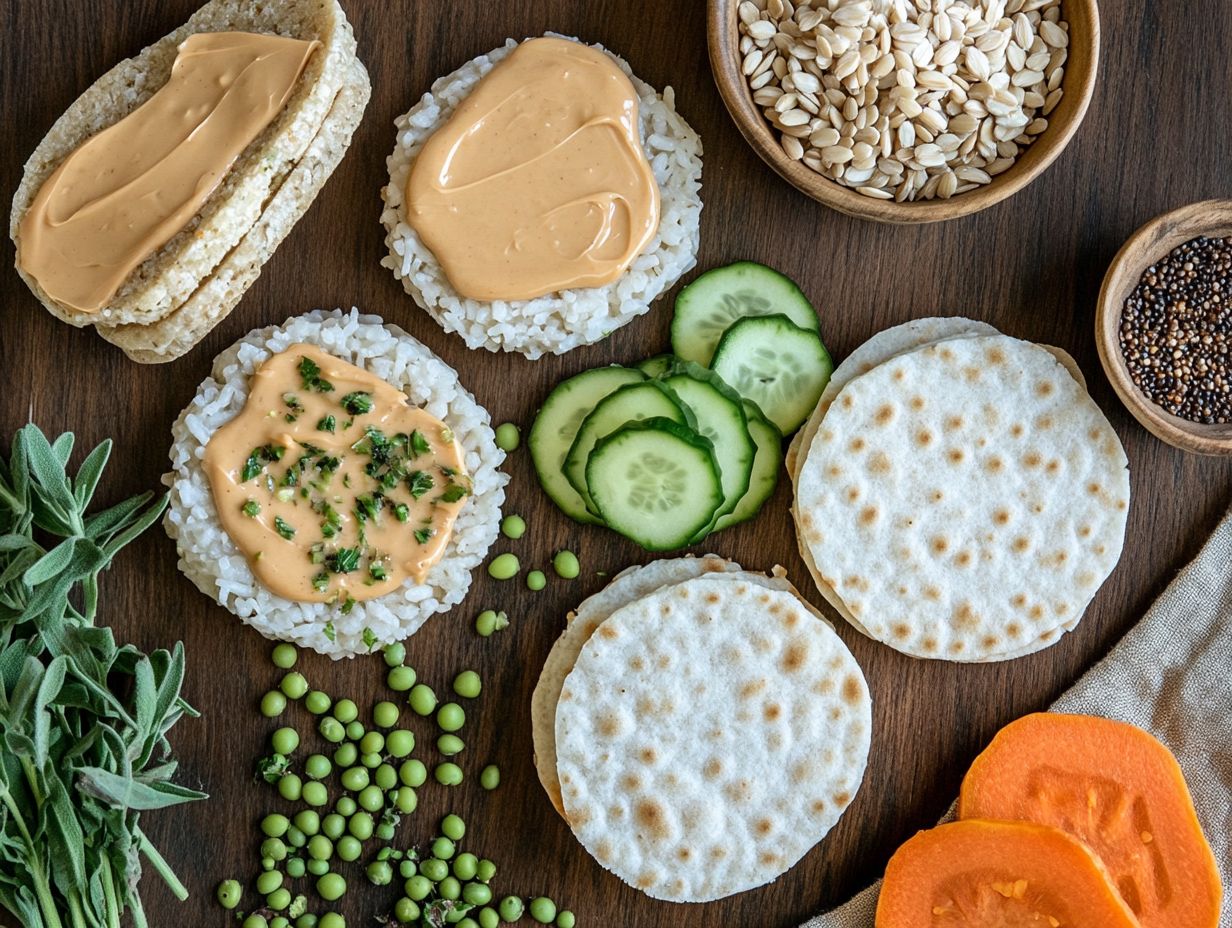
To guarantee that your rice cakes are gluten-free, it s essential to adopt a meticulous approach. Begin by examining the ingredient label with care, seeking out certification marks that affirm their gluten-free status.
Local markets may also offer a variety of naturally gluten-free and vegan options that are labeled accordingly. Be mindful of potential cross-contamination during the manufacturing process.
This level of diligence is particularly crucial for anyone committed to a strict gluten-free diet. Being aware of the risks and choosing quick gluten-free snacks can help manage your diet more effectively.
Check the Label for Gluten-Free Certification
When you’re shopping for rice cakes, the first thing to do is check the label for gluten-free certification. This certification signifies that the product adheres to strict safety standards designed to minimize the risks of cross-contamination.
For anyone with gluten sensitivities or celiac disease, this label provides a welcome sense of security. Additionally, exploring local markets may offer a range of gluten-free options that meet these standards.
Understanding the importance of this certification is essential, as it acts as a reliable safety marker amid the overwhelming array of products on supermarket shelves. A certified gluten-free label assures you that the rice cakes have undergone thorough testing, confirming they contain no more than 20 parts per million of gluten generally recognized as the threshold for safe consumption.
By making it a habit to look for these labels while selecting rice cakes, you can confidently make choices that align with your dietary needs and health. You’ll know you’re opting for products that genuinely prioritize your well-being.
This diligence also applies to other gluten-free snacks like homemade crackers and delicious toppings for rice cakes.
2. Look for Ingredients That Contain Gluten
Another essential step in determining if rice cakes are truly gluten-free involves examining the ingredient label closely for any components that might contain gluten, such as wheat or barley-based additives. This practice is vital for those who must avoid gluten for health reasons. Items like balsamic vinaigrette or mustard can sometimes contain hidden gluten, so thoroughness is key.
Many food products including flavorings, stabilizers, and certain colorings can conceal hidden gluten. For individuals with gluten sensitivities, recognizing these potential sources is crucial since unintentional exposure can lead to discomfort or severe reactions. This vigilance applies to all meals, whether it s a simple mixture of ingredients at home or a quick meal from the store.
As you scrutinize ingredient labels, look out for terms like malt, derived from barley, or ambiguous phrases such as “natural flavors” that might sneak gluten into your snack. Staying informed about gluten-containing ingredients helps you make safer choices, ensuring snacks like rice cakes remain secure and enjoyable options. Be mindful of items like cold cuts or soft goat cheese that could also contain gluten.
3. Check for Cross-Contamination in the Manufacturing Process
To find out if rice cakes are really gluten-free, consider the potential risk of cross-contamination during their manufacturing process, especially if the equipment is also used for gluten-containing products. Being aware of this risk enables you to make informed decisions about your snack choices. Brands that offer certifications and maintain strict safety standards provide more confidence in your choices.
Cross-contamination means that gluten from other foods accidentally mixes with gluten-free items. This is a significant concern for those with gluten sensitivities or celiac disease. It s essential to recognize that not all manufacturers uphold the same safety standards; some take the necessary steps to operate dedicated gluten-free facilities, while others may not. That’s why you should check for certifications and research brand practices.
Carefully examine labels and look for certifications from reputable gluten-free organizations. Researching brand practices and seeking companies that transparently communicate their manufacturing processes can guide you toward safer options. By taking these precautions, you can enjoy your rice cakes with confidence, ensuring your health remains uncompromised. You can also explore rice alternatives that may offer similar benefits.
Can You Make Your Own Gluten-Free Rice Cakes?
Absolutely! Crafting your own gluten-free rice cakes at home is not just straightforward; it also allows you to personalize the flavors and toppings to suit your taste preferences. With just a handful of basic ingredients and a simple recipe, you can create delicious and nutritious snacks that are entirely gluten-free. Ideas for tasty toppings include peanut butter, avocado, or yogurt sauce with fresh herbs.
Preparing these rice cakes in your kitchen gives you the exciting opportunity to experiment with an array of seasonings and add-ins, like fresh herbs, zesty spices, or even delightful sweet toppings. You might try adding black beans, shredded cheese, or pickled onion for a savory twist.
To embark on this culinary adventure, start by gathering your essential ingredients: rice flour, water, and a pinch of salt. The process is refreshingly simple: combine the ingredients until you achieve a batter-like consistency, then pour the mixture into a non-stick pan and let it cook until it reaches that perfect crispiness. You can create a homemade yogurt sauce or a balsamic vinaigrette to serve as a dip or topping.
The best part of making gluten-free rice cakes yourself is knowing you re enjoying a healthy snack without preservatives or added sugars, making them an ideal choice any time of day. This easy recipe can be a staple for quick meals, especially when you add ingredients like tuna, avocado, or soft goat cheese.
Frequently Asked Questions
Summary: Always check ingredient labels for hidden gluten, be aware of cross-contamination risks, and consider making your own gluten-free rice cakes for a healthy and fun snack option!
Are all rice cakes gluten-free?
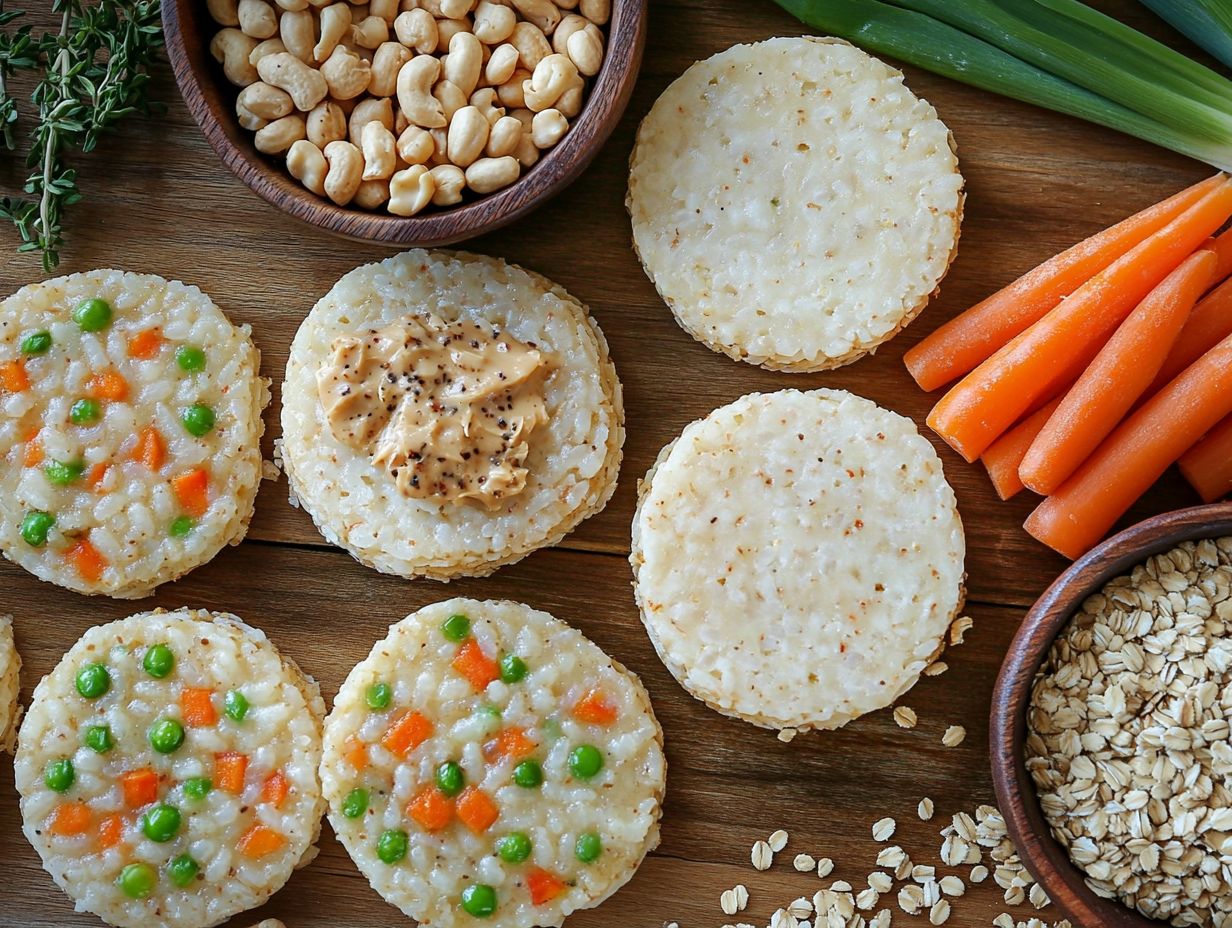
No, not all rice cakes are gluten-free. While rice itself does not contain gluten, it is essential to always check for gluten-free certification to meet your dietary needs.
Do all brands of rice cakes offer gluten-free options?
No, not all brands of rice cakes offer gluten-free options. It is important to read the label and ingredients list to ensure they are gluten-free. Some brands may also provide dairy-free and vegan choices.
Are flavored rice cakes also gluten-free?
Not necessarily. Some flavored rice cakes can contain gluten-containing ingredients, such as soy sauce or seasoning blends. Always check the label for any potential sources of gluten, including flavorings that could hide gluten.
Can people with celiac disease or gluten intolerance safely consume rice cakes?
Yes, rice cakes are generally safe for those with celiac disease or gluten intolerance, provided they are labeled as gluten-free and do not contain any gluten-containing ingredients. They can be quick and tasty snacks in your diet.
Are all rice cake products labeled as gluten-free?
No, not all rice cake products are labeled as gluten-free. Some may be made in facilities that also process gluten-containing ingredients. Always check the label and ingredients list to ensure they are safe for those with gluten sensitivities. Look for other rice options that may work better for you.
Are rice cakes a suitable alternative for those following a gluten-free diet?
Yes, rice cakes are a delicious and versatile snack that anyone can enjoy on a gluten-free diet. They can be topped with a variety of ingredients for added flavor and nutrition. Snack ideas include avocado, nut butter, or smoked salmon for a more satisfying meal.


